If New York City weren’t the national epicenter for COVID-19, then on May 19th, graduating New York University students would have thronged to Grad Alley: a pre-graduation tradition of eating, drinking, and watching performances at the NYU campus right off Washington Square Park. I would have been among them. The day after, I was set to graduate from the NYU Game Center’s MFA program in game design. But like a lot of NYU students, I was no longer in New York City. In March, I’d gone back to my home state of Virginia during spring break, then gotten stuck when Virginia went on lockdown. I hadn’t seen my grad cohort in person for two months. From March to May, I developed my solo thesis project in isolation, with only my partner and the robins nesting in the backyard for in-person company.
Then, on May 15th, I got an email about something called VR Grad Alley. “We invite you to join nearly 20,000 of your fellow graduates for a Virtual Reality Grad Alley where you can meet up with classmates, explore a VR Washington Square Park, and make some last NYU memories together,” it said. The email promised that the experience was accessible from all devices, not just VR-enabled ones. There was one catch: the game would only be available from 5:00 to 9:00 PM, and only on the night of the 19th, just like the real Grad Alley
I was prepared for something small and earnest, the result of six weeks of development time at maximum. Maybe some of my professors at the Game Center, one of the top scholarly institutions for game design in the country, would have contributed mechanics or environments. But the reality was a lonely, half-baked gesture in the direction of virtual worlds, and one that no one I knew from the Game Center had any hand in shaping.
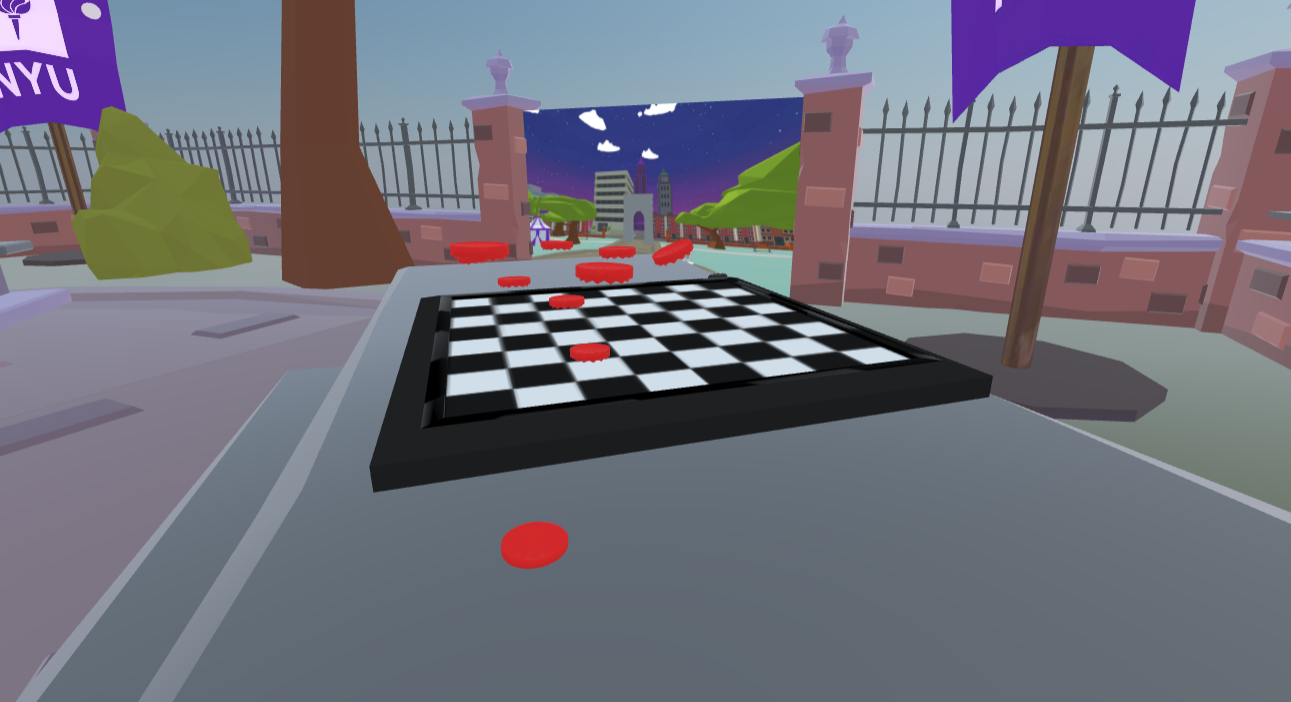
On the night VR Grad Alley was open, I wandered through a deserted, low-poly rendering of Washington Square. The Manhattan landmark, which is usually filled with lively crowds of tourists, students, and chess hustlers, was dead silent. As I looked around, trying to figure out what I should do, I tried to toss a few checkers onto an empty checkerboard. The game pieces stayed suspended in mid-air, as if gravity didn’t affect them.
Then I accidentally pressed a button. I zoomed backwards until the checkerboard was a tiny dot on my screen. What is this lonely wasteland? I typed into the chat. HOW DO I MOVE UP AND DOWN? After five seconds, my messages vanished. No one had responded.
The whole experience was surreal, depressing, and embarrassing. It was a perfect representation of NYU’s response to the coronavirus pandemic.
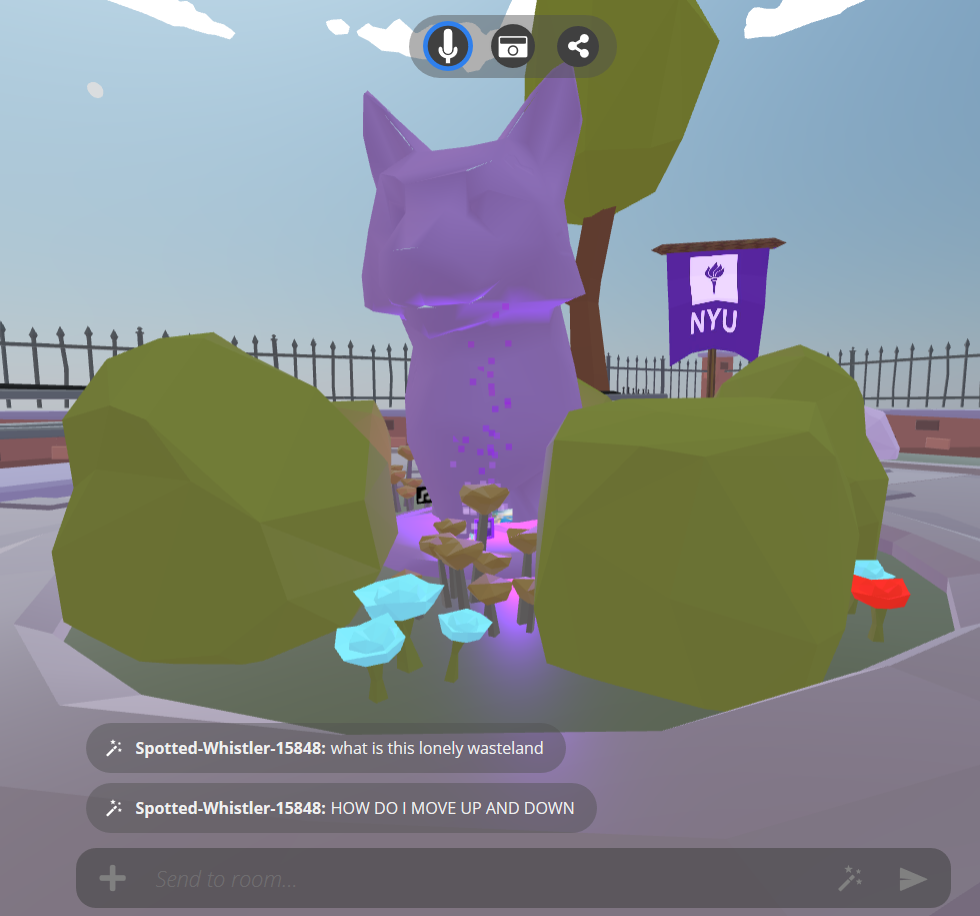
Like many of my peers, I’d been ashamed of the ways in which NYU had treated its students since the pandemic began. On March 16, NYU president Andrew Hamilton sent an email informing us, the university’s 50,000+ students that we had to move out of NYU housing by March 22nd. I live off-campus, so I was unaffected, but the decision stranded students who couldn’t afford to go home or who had unsafe home environments. It was particularly devastating for international students. An email we received on March 17th from Marc Wais, Senior Vice President of Student Affairs, said that NYU had cleared the dorms to make room for COVID-19 patients. To date, NYU has not housed any patients in its empty dorms, though it has housed some medical workers at NYU Langone Health, according to Jason Hollander, a spokesperson for the university.
I was also disappointed in my specific school, the Tisch School of the Arts. As soon as NYU switched to remote learning in March, students had asked the dean of Tisch, Allyson Green, if we’d get tuition refunds. The spring 2020 semester cost $31,721.00 for grad students, and $29,276.00 for undergrads. A key reason why students come to Tisch—including me—is to access concrete resources. It’s not possible to use rehearsal spaces, recording studios, cameras, or 3D printers over Zoom. The students emailing Green wanted to know if they’d at least get refunded for the spaces and equipment they couldn’t use. In response, Green first sent an email saying that “there will be no refunds for tuition and fees for this semester.” That email received a lot of backlash, so several days later, she sent a follow-up: a video of herself doing a graceless interpretive dance soundtracked by REM’s “Losing My Religion.” The pandemic reminded her of friends who had died during the AIDS crisis, Green wrote, and she was trying to dance out her grief. But that came at the bottom of the email, after a 3,000-word message about quarantine logistics. The video was at the top. The least charitable explanation for the video was that Green was mocking the students who had asked for refunds. The most charitable explanation was that she was clueless. NYU has an endowment of $4.3 billion and owns 14.3 million square feet of real estate in Manhattan alone. The school is squeezing every dime from students who were denied the semester they paid for, and who face the worst economic conditions since the 2008 financial crash, contributing to their financial hardship for the kind of money that is practically meaningless compared to NYU’s assets. Students understood how much money was in its coffers, and a banal video performance wasn’t the same thing as financial support.
The result was that I didn’t trust NYU. I had a dim hope that NYU had managed to harness the power of virtual experiences in a way that made us feel like we really were graduating together. But I had far more doubts and questions about the project.
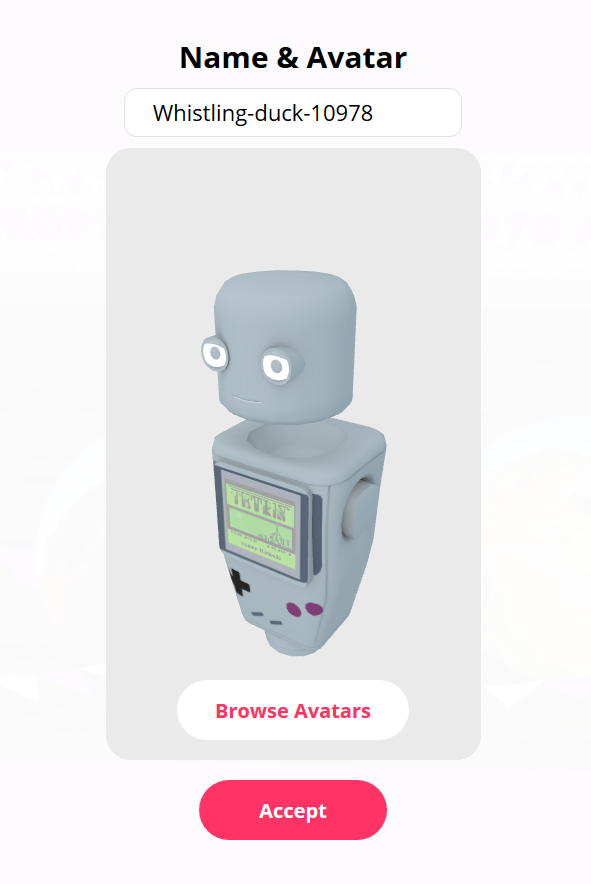
When I logged on to VR Grad Alley. I was assigned a randomly generated username, Whistling-Duck-10978, and told to pick a skin for my avatar, which looked like a Hitachi Magic Wand with eyes. After I flicked through a few textures—graduation robe, panda, hoodie—I settled on a Game Boy. I looked at my avatar and it stared back at me with empty eyes, a Game Boy pattern on its chest the only marker of me.
The first room I spawned into was a selfie room. A selfie station, complete with a banner that said ‘CONGRATULATIONS’ and a frame for avatars to pose behind, beckoned me forward. But there was no one to pose with, and no way to make my avatar smile, or frown, or laugh. I took a picture of my expressionless avatar standing alone behind the picture frame. Congratulations, I thought, and felt depressed.
I wandered into another room, this one a recreation of Washington Square Park itself, and dropped the link to the room into the Game Center Discord. Use this code if you want to join me I…think? I wrote. After a few minutes, another blank-faced avatar spawned across the square from me. HELLO! I shout-typed. It was my classmate, Varun. I had never been happier to see him (though it took us a while to figure out each other’s identities due to our randomly-generated usernames).
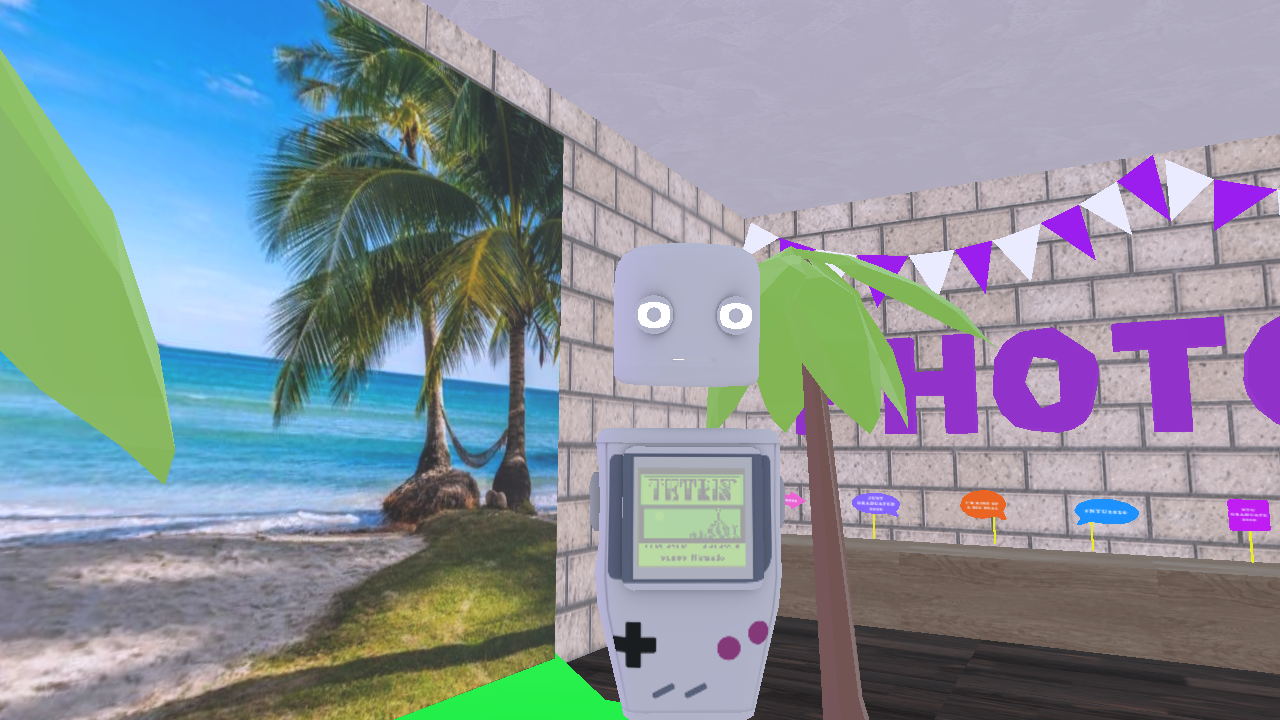
Together, we tried to play checkers. There was no point. The game pieces hovered stubbornly, refusing to touch the board. We tried chatting, but messages disappeared quickly, and there was no chat log. Finally, we tried to circle each other like villagers in Animal Crossing: New Horizons, but playing without VR meant that depth was difficult to perceive. We zoomed around each other in a haphazard tango. At last, Varun embarked on a much more important task: dropping video clips of Allyson Green’s dance at random points around the fountain.
I checked Discord. Another classmate, Chris, had entered the rooftop dance room and posted a link. I dropped into a room with music I could barely hear. Chris was nowhere to be found. I’m floating back from the edge of the universe, he typed. He had figured out that there was no limit to how high he could rise from the roof, so he’d flown through the sky until he passed effortlessly through the skybox and saw the world below bend in on itself. Alone on the rooftop dance floor, I spawned a small herd of crying emojis.
Once Chris came back, we tried talking for a few minutes, but messages disappeared so fast that we couldn’t keep the conversation going. See you on the better Internet, he wrote, and left. I waited around to see if anyone else would show up. No one ever did, so I also left, this time for good.
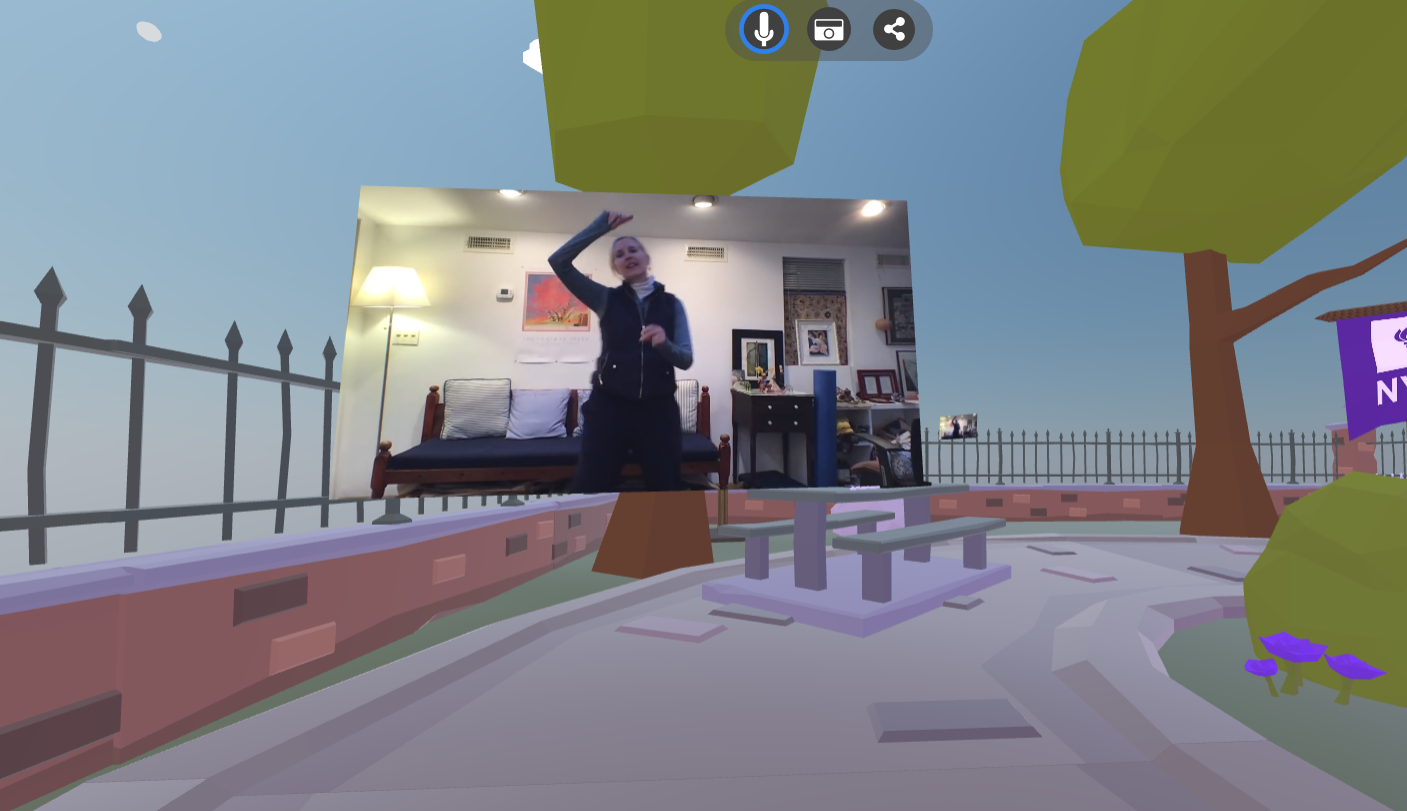
Never, at any point during the pandemic, had I felt so alone. Here, Washington Square Park was emptier than in real life, which I knew from talking to classmates still in New York City. At least people were there, though they wore masks and kept their distance from each other. At least there were rats in real life.
I also messaged Mitu Khandaker, a professor at the Game Center with a PhD in the aesthetics of interactivity in video games. (Disclosure: I have taken a course with her.) She didn’t know about VR Grad Alley until I tweeted about my disheartening experience, she said. This struck me as bizarre, since Khandaker is both a VR academic and a game developer. She probably could have offered quality feedback. However, as soon as she knew VR Grad Alley existed, she checked it out. “My overarching impression really was of how empty it was—which honestly made me feel sad for the students!” she told me. She spent most of her session wandering around the Washington Square Park location, where she encountered a lone student she didn’t know. “I congratulated them on graduating -- and they asked ‘where is everybody?’” said Khandaker. The interaction “kind of broke my heart.”
Khandaker said she could see what NYU was going for: “somewhere for students to congregate and with the space for a lot of user generated content.” A space that she thought truly accomplished those goals was a version of the Game Center MFA workspace that MFA student Yuxin Gao created in Habboon, a free, retro version of the virtual world Habbo. On May 1st, Gao oversaw a virtual graduation attended by both students and faculty. Graduating students, represented by avatars dressed in a wild array of outfits, had a photoshoot and then hit the dance floor. Someone brought a horse, which also hit the dance floor. Sparkles flashed, and a flurry of “congrats!!” messages hovered over users’ heads. Then everyone set the Game Center on fire and went to Chili’s. A recreation of Chili’s in Habboon, that is.
“What ultimately made it a great experience is everyone was able to put in something to add onto the experience,” said Gao when I asked her. “Raye was DJing the Zoom voice chat. Emily invited us to her [Chili’s] restaurant to have the afterparty. Lillyan was there leading the coordination of the photo shoot. There were friends just watching on the side and they were excited for the grads.”
Here's a Twitter thread here with screenshots:
Jason Hollander, Assistant Vice President of Communications, said in an email that VR Grad Alley had over 3,000 unique users. That’s far greater than the number of people who attended the Habboon graduation, but the Habboon environment was much more intimate and effective as a virtual space for celebrations. Besides, the 3,000 number confused me. If there were 3,000 users, then why did hardly any of us encounter each other?
The day after VR Grad Alley, I researched the open-source Mozilla Hubs software, on which VR Grad Alley was based. It debuted in 2018 as a mixed-reality experiment from Mozilla, and that’s still what it feels like: an experiment. The control scheme is hard to use, whether the user has VR equipment or not.
Peter Sterne, an advocacy journalist, played VR Grad Alley on an Oculus Quest with his girlfriend, Emily Joshu, who was about to earn her MS in publishing from NYU. “The control scheme was bizarre,” said Sterne, who struggled with movement basics like rotating and going forward. The whole experience “was so amateurish and broken that it was frustrating to use,” he said.
NYU is not the only organization turning to Hubs during the pandemic. Space Popular, a London-based architecture firm, used it to create AA Earth Gallery, an online art gallery celebrating fifty years of Earth Day. AA Earth Gallery is mesmerizing, easy to navigate, and leans into the weirdness of Hubs to create a museum where the space itself is part of the installation. VR Grad Alley is the opposite. Its hodgepodge of textures, low-poly models, and inconsistent audio created a sensation of techno-dread. Some might call this style glitch art or vaporwave, but glitch art is intentional. VR Grad Alley was the result of next to no development time. What’s more, games and films that use glitch art are usually made by fringe or indie creators. But NYU is not fringe.
According to the ‘About’ page for VR Grad Alley, the experience was developed by the Office of Public Affairs and the Office of University Events in conjunction with student and faculty consultants, as well as Jump Into the Light, a VRcade and developer. I emailed Jump Into the Light to ask for details about the project’s development timeline and costs. Though I received an initial response from someone who identified himself as a member of the development team, they stopped responding to my emails soon after. I also asked the Office of Public Affairs for the same information, plus a few other questions: who, specifically, came up with this idea? Who were the student and faculty consultants? Were they credited anywhere? Were they paid? And had NYU reconsidered its decision on offering refunds, especially since the school is now the subject of a class-action lawsuit?
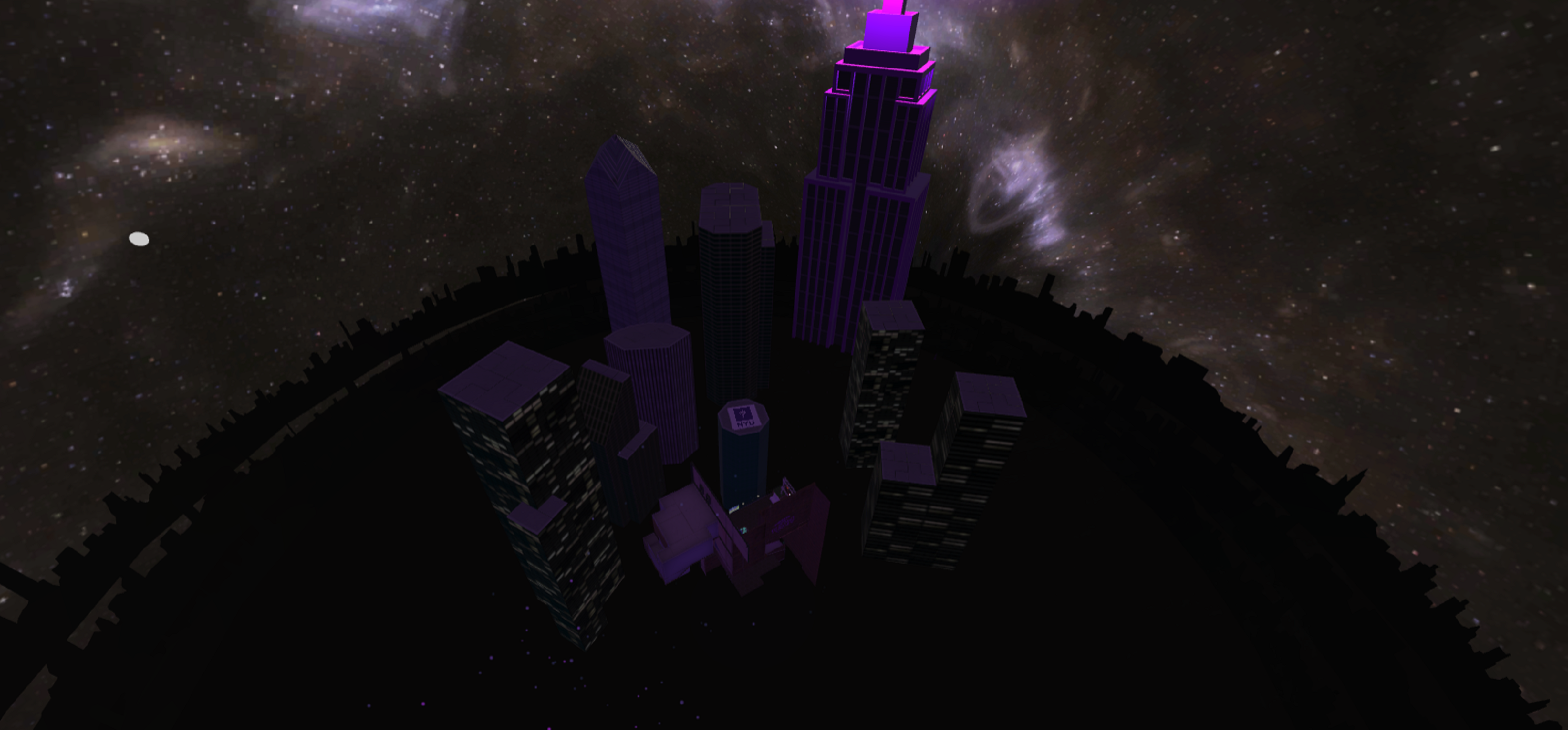
“We don't give out budget information on costs associated with individual programmatic endeavors. But one thing I do know is that it cost a fraction of what a traditional Grad Alley would run,” said Hollander in an email. He declined to answer my other questions, but did point me to a pre-existing statement about refunds by NYU spokesperson John Beckman. The final sentence of Beckman’s statement: “Given our commitment that the education of our students will proceed through the end of the semester, NYU, like most top universities… will not refund tuition.”
Ultimately, I have no way of knowing what the dev team wanted to convey with this or that room, or what resources they were working with, or even who was part of the team (students? Professors? Who knows?).
The way VR Grad Alley came across, at least to me, was a final expression of contempt. As if someone thought, What do kids like these days? They like games, don’t they? As if the concept of a capital-g Game—the shapeless, abstract kind, embodied in stock photos of cheerful Gamers piled on a couch, playing on a Console, collecting Things and having Interactions – would be enough. As if an Interactive Experience might wallpaper over the hardship and suffering that NYU didn’t have to—but still chose to—inflict on its students. Instead, NYU chose to make this.
Congratulations.
from VICE https://ift.tt/2ZMkcfu
via cheap web hosting
No comments:
Post a Comment